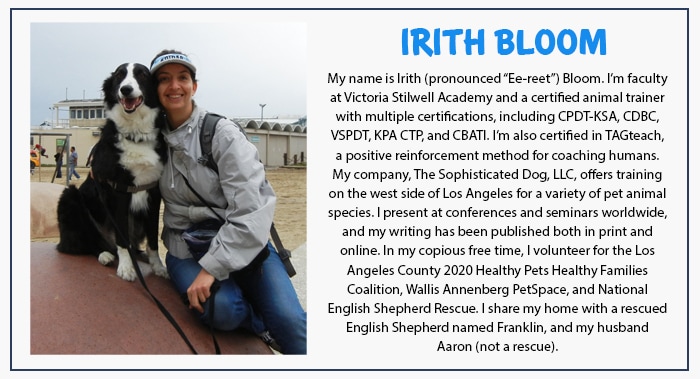Contributed by Irith Bloom, faculty at Victoria Stilwell Academy and certified animal trainer with multiple certifications, including CPDT-KSA, CDBC, VSPDT, KPA CTP, and CBATI.
Trick or Treat, Meet Irith!
My name is Irith (pronounced “Ee-reet”). I’m a certified professional animal trainer based on the west side of Los Angeles. When I’m not helping clients or speaking at seminars, I spend my time with my husband and our wonderful, nearly 14-year-old English Shepherd, Franklin.
Franklin is a rescue. When we first got him, he had some pretty troubling habits. One of them was barking at the doorbell. This behavior can make holidays like Halloween pretty uncomfortable. The first Halloween we had Franklin, I considered pretending nobody was home, to avoid people ringing the doorbell. However, as a professional who works with animals, I knew there were other options for how to train your dog not to bark.
When I’m dealing with a nervous dog (like Franklin used to be), I like to start with one of a variety of calming remedies. There are a lot of options available, such as Sentry HC Good Behavior Pheromone Dog Calming Collar. A nervous dog may also become calmer with the use of calming supplements, such as VetriScience Composure Behavioral Health Bite-Sized Dog Chews, which can be given daily to reduce stress in dogs with anxiety. They’re also yummy, and have the Franklin seal of approval.
Calming remedies can be very helpful in reducing a pet’s baseline levels of stress, but using them alone rarely resolves a serious behavior—and Franklin needed more than just Comfort Zone with Adaptil products to learn not to bark at the doorbell. Fortunately, I know how to calm a dog down.
There is more than one option for training a dog to keep calm when the doorbell rings, but the training technique below is the one I recommend to most clients, since it is fairly straightforward, and can also be modified to work with cats, birds and other animals.
Training Step by Step
1. Begin by recording your doorbell, as well as a knock on your door. Most cell phones can do this.
2. Starting at low volume, play the sound of the doorbell or knock. The goal is for the dog to hear the sound, but not run away or start barking. If the dog gets agitated, lower the volume. It took a few tries to find the right volume for Franklin.
3. Right after playing the sound, toss three to five tiny dog treats on the floor, away from the door. “Tiny” means smaller than your pinky nail; chop the treats into small pieces if necessary. If you have a very small dog, the treats should be even smaller. The goal is for your dog to be able to eat a few dozen treats without filling up or getting a tummy ache. Franklin likes Zuke’s Mini Naturals Chicken Recipe Dog Treats, which are pretty small—though I still cut them in half for him, and he weighs about 60 pounds. Many of my smaller dog clients enjoy Stella & Chewy’s Duck Duck Goose Dinner Patties, which can be easily shredded into small flakes or bits.
4. Work in sessions that last no more than 5 minutes, and take breaks of at least 30 minutes between sessions. Repeat steps two and three until your dog is obviously anticipating the treats when he hears the sound.
NOTE: If your dog barks after hearing the sound, toss the treats anyway. I know that sounds counterintuitive, but the goal here is to associate the sound with food. The barking lets you know the volume was too high, and you should try a lower volume next time, but in the meantime, give your dog the treats anyway.
5. Once your dog is consistently quiet at the first volume setting, increase the volume slightly and repeat the process.
6. Gradually build up until you can play the sound at full volume while your dog stays quiet and eats the treats. Practice until the dog can handle both sounds calmly.
7. Next, try using the actual doorbell or knocking on the door, and then tossing treats. You can get a friend to do the knocking and ringing for you. I suggest you reward your friend for the help with some tasty human treats (flourless chocolate cake is a favorite among my helpers, but make sure your pets don’t steal any).
8. Eventually, I worked up to saying, “Just a minute” right after the doorbell, or knocking and then tossing the treats. Once Franklin got used to that, I started to open the door briefly and talk to the person while continuing to throw treats to Franklin.
With practice, your dog—like Franklin—will learn that the doorbell is not an occasion for barking, but an opportunity to hunt for treats away from the door. If you want to make sure your dog doesn’t escape as you open the door, put up a barrier such as a baby gate (the Carlson Pet Products Extra Wide Walk-Thru Gate with Pet Door is a good choice) and toss the treats to your dog behind the gate.
With a little forethought and training, you can make Halloween a safer and happier holiday for everyone in your household. So, go out there and get started!

All About the Bark
Share:














